E-Verify desk reviews have become a focal point for many employers in the US. As compliance scrutiny intensifies, understanding its intricacies is crucial for organizations to ensure adherence to E-Verify regulations.
This blog aims to demystify the desk review process, explaining its purpose, key components, and steps to ensure a successful outcome.
What is E-Verify?
E-Verify is an internet-based system that compares information from an employee’s Form I-9 to records in government databases to confirm employment eligibility. It’s a voluntary program for employers but is compulsory for certain federal contractors.
Who is an E-Verify Employer?
As already stated, the program is mandatory for specific categories of employers:
Federal Contractors: Companies that contract with the federal government are required to use E-Verify.
Subcontractors: Businesses that subcontract with federal contractors must also participate in E-Verify.
State and Local Government Mandates: Some states and localities have their own E-Verify mandates, requiring specific employers within those jurisdictions to participate.
It’s important to note that while E-Verify participation is voluntary for most employers, it can be a strategic decision to ensure compliance and maintain a legal workforce.
What is an E-Verify Desk Review?
An E-Verify desk review is a compliance check performed by the E-Verify Account compliance team to confirm employers adhere to program guidelines. This process involves meticulously examining an employer’s employment verification methods, including document retention, recordkeeping, and overall E-Verify usage. Desk reviews generally involve phone calls, emails, and document requests.
What is the purpose of E-Verify Desk Reviews?
The primary objective of E-Verify desk reviews is to assess an employer’s compliance with E-Verify program guidelines. By conducting these reviews, the E-Verify Account Compliance team aims to:
Verify Program Adherence: Ensure employers accurately follow E-Verify procedures and policies outlined in the Memorandum of Understanding (MOU).
Identify Compliance Issues: Detect potential areas of non-compliance, such as errors in Form I-9 completion or improper document retention.
Provide Guidance and Assistance: Offer employers support and clarification on E-Verify requirements and best practices.
Enhance Program Integrity: Strengthen the overall integrity of the E-Verify system by detecting and addressing potential vulnerabilities.
Through desk reviews, E-Verify aims to promote a fair and legal workforce while providing employers with the necessary tools to maintain compliance.
E-Verify Desk Review Process Explained
The desk review process generally follows these steps:
Selection: Employers are chosen for a desk review based on factors such as E-Verify usage patterns or potential compliance issues.
Notification: Employers receive a notification from E-Verify Account Compliance summarizing the scope of the review and the documents required.
Document Submission: Employers submit requested documents, including Form I-9s, employment eligibility verification documents, and E-Verify case information.
Review and Analysis: E-Verify compliance staff carefully examine the submitted documents to evaluate compliance with E-Verify guidelines.
Feedback and Guidance: Based on the review findings, compliance staff provide feedback and recommendations to the employer.
How does E-Verify Select a Participant for a Desk Review?
The E-Verify selection process for desk reviews is based on various factors, including but not limited to:
E-Verify Usage Patterns: Employers who exhibit unusual or inconsistent use of the system may be selected for review.
Compliance Risk Indicators: Certain patterns or practices identified within an employer’s E-Verify account may trigger a review. This may include patterns of Tentative Non Confirmations (TNCs), inconsistencies in Form I-9 completion, or other indicators of potential issues.
Random Selection: A portion of employers are selected randomly to assess overall program compliance.
When an employer is chosen for a desk review, they will typically receive a notification via email or phone from E-Verify Account Compliance outlining the next steps. The desk review allows participants to discuss difficulties or issues using E-Verify with Account Compliance.
Note: Any employer using E-Verify could be selected for a desk review, regardless of company size or industry.
E-Verify Desk Review Acceptance Notification
When selected for an E-Verify desk review, employers will receive a formal notification outlining specific requirements and expectations. This notification typically includes:
Document Request: A detailed list of documents required for the review, including Form I-9s, supporting documentation, and E-Verify case information.
Document Submission Guidelines: Instructions for securely transmitting requested documents, often specifying file size limitations and password protection requirements.
Compliance Assessment: A clear statement that the review aims to assess compliance with E-Verify regulations and procedures.
Timeframes: A specific deadline for submitting the requested documentation, typically within 10 federal government working days. Failure to comply can result in severe penalties, including termination of E-Verify participation.
Self-Assessment: Employers may be required to complete a self-assessment to evaluate their E-Verify practices.
Accompanying the notification are usually three essential documents:
Request for Documents: A detailed list of specific E-Verify cases to be reviewed.
E-Verify Profile Confirmation Form: Used to verify the accuracy of the employer’s information on file.
Self-Assessment Guide: A questionnaire designed to help employers evaluate their E-Verify practices.
It’s crucial for employers to respond promptly and accurately to the desk review notification to avoid potential issues.
Below is an email sent by E-Verify notifying the Desk Review:
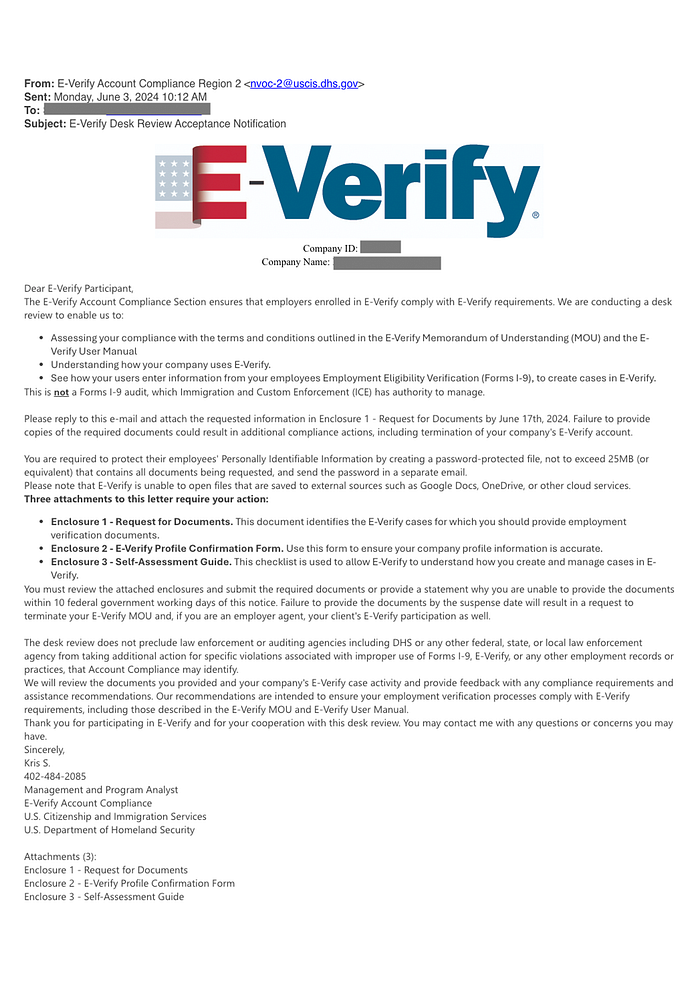
Enclosure 1- Request for Documents typically outlines the specific E-Verify cases selected for review:
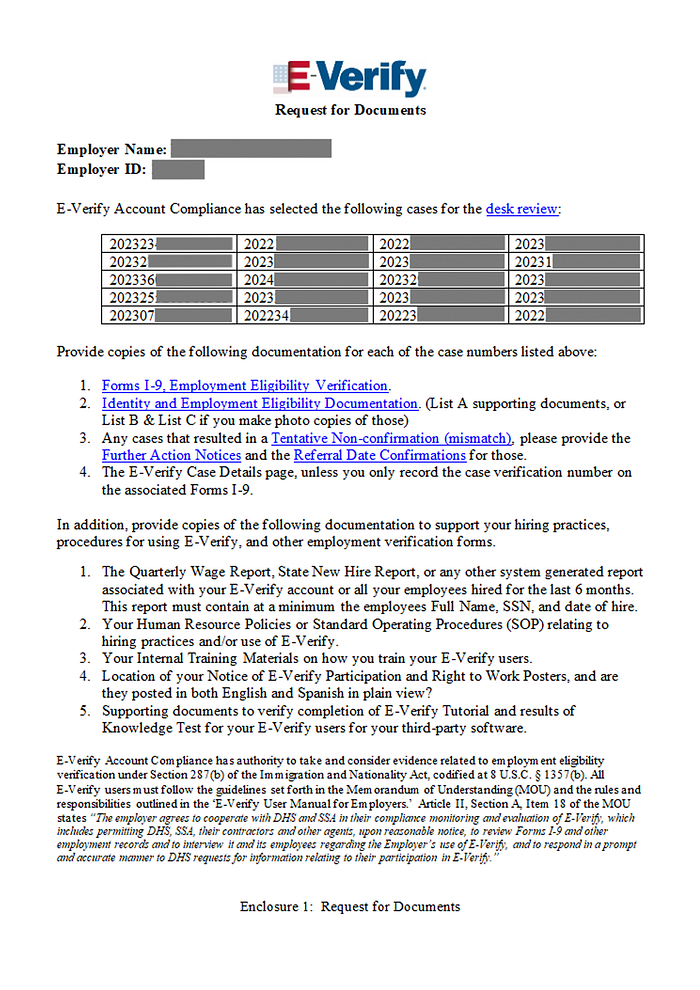
Here is a sample of the Enclosure 2 — Profile Confirmation Form:
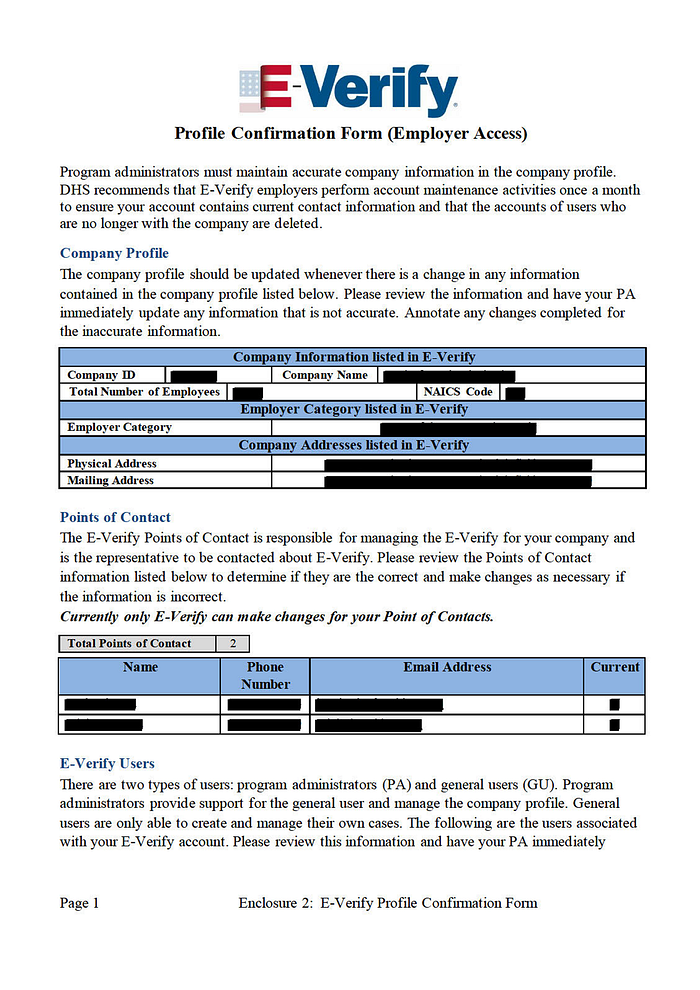
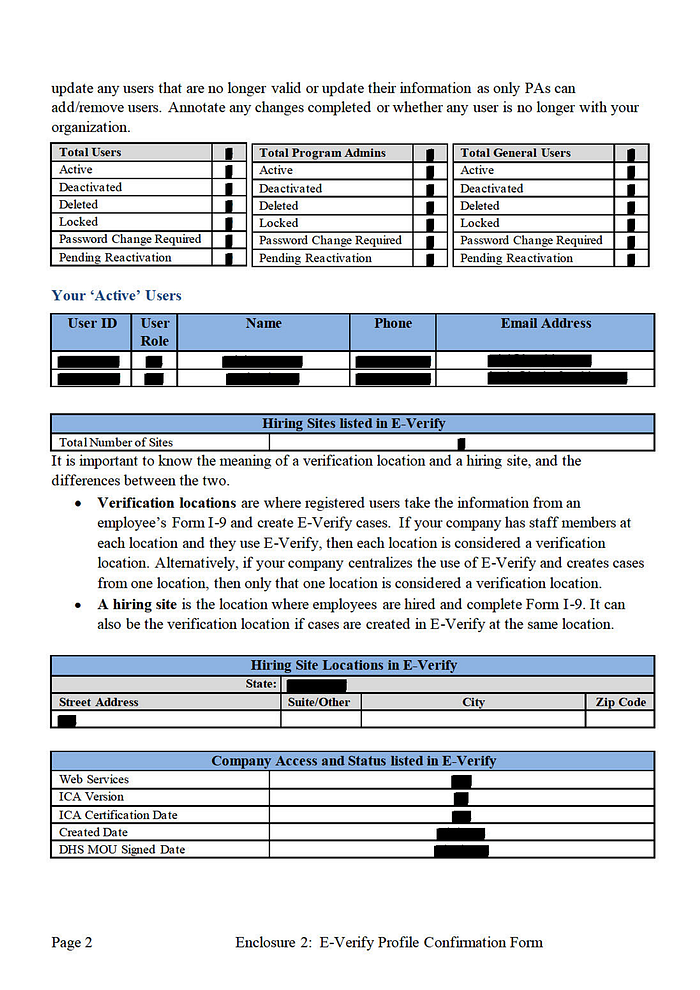
Besides these, an E-Verify Self Assessment Guide (M-1043) is enclosed. It is provided to assist employers in maintaining E-Verify compliance. It outlines best practices, identifies potential risk areas, and offers guidance on improving E-Verify usage. By completing the self-assessment, employers can identify strengths and weaknesses in their E-Verify processes, implement corrective actions, and reduce the likelihood of compliance issues. The guide covers various aspects of E-Verify, including Form I-9 completion, case management, and recordkeeping.
E-Verify Desk Reviews: Mistakes to Avoid
Understanding common pitfalls can help employers prepare for and successfully navigate a desk review. Here are some frequent areas of concern:
Form I-9 Completion Errors: Mistakes in completing Form I-9s, such as incorrect dates, missing information, or improper document selection, are common issues.
Document Retention: Employers often struggle with maintaining accurate and organized records of Form I-9s and supporting documentation.
E-Verify Case Management: Incomplete or inaccurate information entered into the system can lead to discrepancies and delays.
Tentative Non Confirmations: Handling TNCs appropriately, including timely resolution and proper documentation, is crucial.
Recordkeeping for Terminated Employees: Maintaining records for terminated employees and understanding retention requirements is essential.
For a smooth desk review process, employers can:
Maintain Accurate Records: Keep meticulous records of all Form I-9s, employment eligibility verification documents, and E-Verify case information.
Stay Organized: Develop a system for efficiently storing and retrieving required documents.
Respond Promptly: Respond to E-Verify requests in a timely manner to avoid delays in the review process.
Seek Clarification: If you have any questions or concerns, don’t hesitate to seek clarification from E-Verify Account Compliance.
Implement Corrective Actions: Address any identified compliance issues promptly and thoroughly.
By following these guidelines, employers can increase their chances of a successful desk review and maintain E-Verify compliance.
Is There a Link Between E-Verify Desk Reviews and I-9 Audits?
While not a guaranteed outcome, there is a heightened possibility of an on-site audit or investigation following an E-Verify desk review. The desk review serves as a preliminary assessment of an employer’s compliance, and if irregularities or systemic issues are identified, it could trigger further investigation.
The Department of Homeland Security (DHS) has the authority to conduct workplace enforcement actions, including audits and investigations, to ensure compliance with immigration laws, including E-Verify regulations. As 8 CFR Part 274a outlines, all employers are subject to potential audits and investigations. While a desk review is not synonymous with an audit, it can be seen as a forerunner, providing authorities with valuable insights into an employer’s E-Verify practices.
Numerous reports indicate that employers who have undergone desk reviews subsequently faced on-site audits or investigations. These follow-up actions often involve more stringent document verification, employee interviews, and potential penalties for non-compliance.
Therefore, employers must treat desk reviews seriously and take necessary steps to ensure compliance.
The following is a sample STEM OPT Employer Site Visit Notification received by an employer subsequent to an E-Verify desk review:
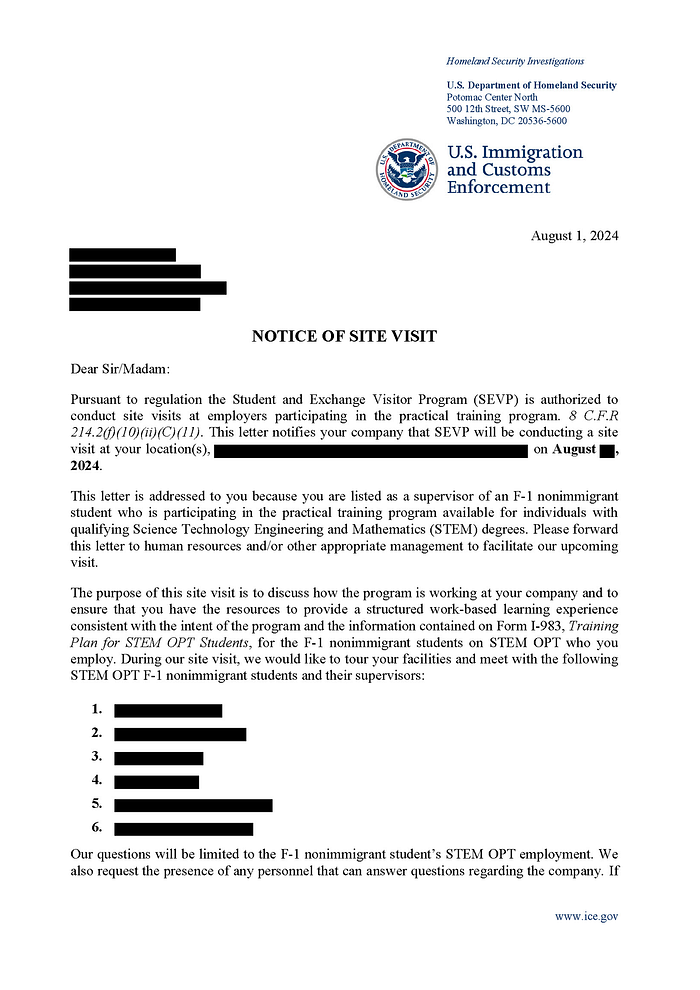
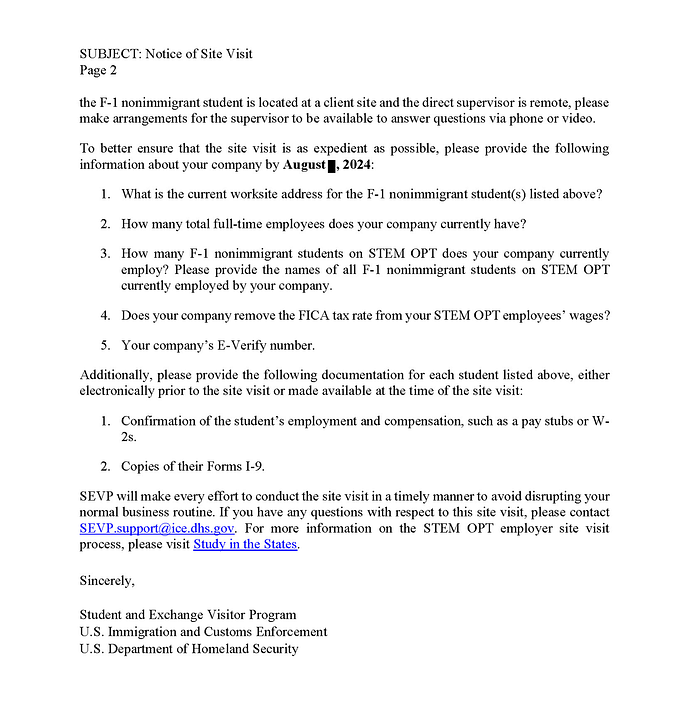
Summing Up
An E-Verify desk review is a compliance inspection conducted by the E-Verify account compliance team to ensure employers accurately utilize the system. This in-depth review examines an employer’s employment eligibility verification practices, including Form I-9 completion, document retention, and E-Verify case management.
Understanding the E-Verify desk review process is crucial for employers seeking compliance. Employers can mitigate risks and strengthen their E-Verify program by proactively preparing for a potential review and addressing any identified issues. While desk reviews are a compliance tool, it’s essential to recognize that they can also serve as a precursor to more comprehensive audits by the U.S. Immigration and Customs Enforcement (ICE). By prioritizing E-Verify compliance and implementing robust internal controls, employers can foster a culture of compliance within their organizations.
